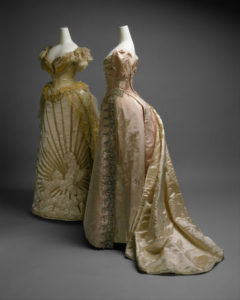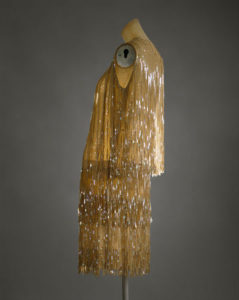
Bustle gowns from the late 19th Century.
Women have the gift of metamorphosis. Using clothes, hairstyles and makeup, they can change their faces and the shape of their bodies while making statements about independence, sophistication and sexual attitudes.
In the process, they turn whole cultures upside down.
That’s the story of this year’s Costume Institute exhibit at the Metropolitan Museum: “American Woman: Fashioning a National Identity.” It draws on a collection that was given to the Met by the Brooklyn Museum in 2009. Using about 80 high fashion pieces, it follows women through a series of transformations between the years 1880 and 1940.
It’s surprising how much social history can be gleaned from the simple index of what clothes rich women were wearing in any given decade.
In this narrative, American women went from being heiresses in silk gowns to athletic “Gibson Girls” to exotic aesthetes to no-nonsense suffragettes to androgynous flappers to sexy sirens.

The artsy look of the 1910s.
The heiresses of the late 19th century were the wives and daughters of industrialists with names like Vanderbilt, Frick and Rockefeller, the types depicted in portraits by John Singer Sargent and novels by Edith Wharton. Their ball gowns – black for the older women, ivory for the younger — were shaped with tight bodices and waspish waists and lavishly embroidered with sequin silk threads, rhinestones and beads.
The “Gibson Girl,” was largely the creation of an illustrator named Charles Dana Gibson, who drew her as an “American type” in an 1890 edition of Life magazine. She was an athletic, free-spirited young woman, with her hair pinned up in loose bun, or chignon (the designers’ attempt to capture this in towering stiff coiffures may be the only misstep in this show).
Gibson Girls wore long white tennis skirts, bifurcated ones for bicycling, and asymmetrically-designed ones for sidesaddle horseback riding. For all their vitality and athleticism, however, they didn’t stop wearing corsets.
To call the female archetype of the art nouveau period “The Bohemian,” seems a stretch, given their wealth. They were more likely to be art patrons than garret dwellers, but the label does capture their fascination with the arts and exotic clothing. The mannequins are displayed in a set based on Louis Comfort Tiffany’s studio with a soundtrack from Debussy’s “Afternoon of a Faun.” One such bohemian, “the fabulous Rita Lydig,” had 300 pairs of shoes, most of them covered in in lace.
The section devoted to the “Suffragist” and “Patriot” archetypes of the 1910s, has no haute couture designs. These women wore plain, comfortable clothes to emphasize their seriousness and to accommodate all the rigorous marching and campaigning they had to do.

Flapper dress of the 1920s.
The most extreme metamorphosis came in the 1920s with the arrival of the flapper. Flappers had rouged lips, bobbed hair and accessorized with cigarette holders. They were sexual liberated and yet it’s never explained why such an attitude was expressed in clothing that suppressed their sexual characteristics. Their chemise-like dresses made them flat-chested and narrow hipped. Translated into haute couture, the flapper look involved oodles of satin tulle, silvery metallic thread and iridescent beads.
The final group is represented by the “Screen Sirens” of Hollywood’s golden age. In the 1930s, the boyish flapper look was exchanged for the voluptuary look. These sirens wore second-skin gowns that emphasized Venus-like proportions. It’s epitomized by a dress designed by Travis Banton for Anna May Wong in the film Limehouse Blues (1934).
The final gallery might have been left out. It displays rapid-flashing images of women, ranging from Venus Williams to Lady Gaga that create the impression that life has changed too fast and gone in too many directions for the kinds of intriguing generalizations of the previous galleries.

